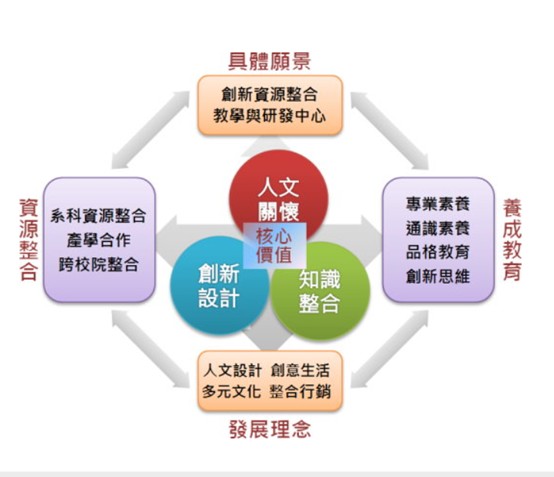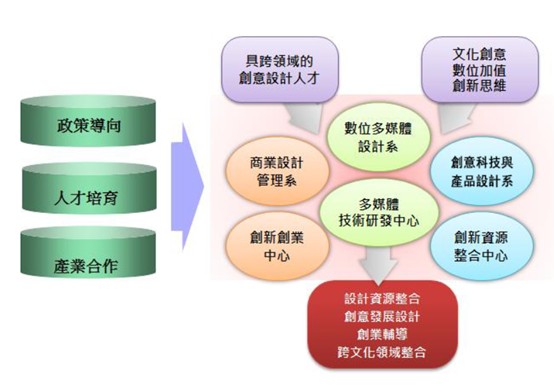School of Innovative Design and Management
School of Innovative Design and Management
Founding Vision and Purpose
Established in the 2014 academic year at the Taoyuan Campus, the School of Innovative Design and Management underscores the University’s emphasis on innovation and creativity rooted in a rich tradition of commerce. Its mission is to ensure sustainable development and revitalize the prestigious legacy of National Taipei University of Business(NTUB).
The School oversees four academic units: Department of Commercial Design and Management, Department of Digital Multimedia Design, Department of Creative Technologies and Product Design and Institute of Creative Design and Management.
The University’s development strategy considers the unique attributes of the Taoyuan Campus(Pingzhen) - its geographic setting, available resources, space and facilities, faculty characteristics, collaborative projects with industry and government, developmental goals, student needs and demographics, talent cultivation objectives, industry demands, societal recognition, and administrative support - as key reference points for the planning and positioning of the School of Innovative Design and Management.
Core Values
“Humanistic Care, Innovative Design, and Knowledge Integration” - Located in Pingzhen, Taoyuan, the School benefits from abundant natural and industrial-commercial resources. With the development of the Taoyuan Aerotropolis and the government's promotion of the cultural and creative industries and leisure tourism, the School closely aligns its departmental growth with regional industry.
With “humanistic care, innovative design, and knowledge integration” as its core values, the School strives to become the design innovation service hub of Northern Taiwan and to nurture creative design talents with cross-disciplinary integration capabilities. Students are guided to develop innovative, cross-disciplinary design skills through a curriculum that emphasizes local resource integration and innovation, global and multicultural awareness, industry-academe collaboration, creative thinking, marketing integration, digital literacy and workplace ethics.

|
|
具體願景Vision 創新資源整合Innovation Resource Integration 教學與研發中心Teaching and R&D Hub |
|
|
資源整合Resource Integration 系科資源整合Departmental Resource Coordination 產學合作Industry-Academe Collaboration 跨校院整合Inter-College Integration |
人文關懷Humanistic Care (核心價值Core Values) 創新設計Innovative Design 知識整合Knowledge Integration |
養成教育Foundational Education 專業素養Professional Literacy 通識教育General Education 品格思維Character Building 創新思維Innovative Thinking |
|
|
發展理念Development Concepts 人文設計Humanistic Design 創意生活Creative Lifestyle 多元文化Multiculturalism 整合行銷 Integrated Marketing |
|
Development Features
The School of Innovative Design and Management is founded on the core principles of humanistic care, innovative design, and knowledge integration, emphasizing both humanistic values and creative innovation to cultivate interdisciplinary talent in design and management. By integrating resources across departments and faculties, both within and beyond the university, and fostering mutual support and shared resources, the school strives to enhance the quality of teaching, research and administrative services. This effort aims to elevate the standard of creative design education in Taiwan while promoting internationalization and diversification. The school’s development direction includes areas such as digital creative value-added services, creative lifestyle design, integrated marketing, cultural and creative industries, leisure and cultural management and digital content. It seeks to nurture creative design professionals aligned with the needs of national development. The undergraduate curriculum is student-centered, focusing on learning and career development. Emphasis is placed on humanities literacy, creative thinking, practical skills, internships, hands-on experience, and capstone projects. The curriculum addresses industry needs and fosters cross-disciplinary design capabilities by integrating the resources of its three departments and offering a variety of themed courses.
Development Goals
The School aims to strengthen its educational focus on humanistic care, innovative design, and knowledge integration, with the goal of enhancing Taiwan’s global competitiveness in creative design. In line with the University’s mid- to long-term development plans and its key talent cultivation programs, the School will develop comprehensive support in faculty, curriculum, and facilities to nurture professionals in creative and management fields, becoming a driving force in Taiwan’s creative industries.
It also seeks to establish itself as a center for innovation, resource integration, and R&D in teaching. By integrating resources from the School of Innovative Design and Management, other academic departments, and regional industries, the School will serve as a platform for academic, industry and government collaboration - enhancing the value of industry-academia cooperation through creative resource sharing and integration.
Promoting Industry-Academia Collaboration and International Exchange: By integrating the School’s and centers’ teaching and research resources - both hardware and software - we promote industry-academe collaboration and international exchange to broaden students’ perspectives and enhance their competitiveness.
We aim to become a leading institution for creative design in northern Taiwan, building a comprehensive teaching framework that combines theory and practice, establishing various exhibition and design centers, strengthening faculty structure, and advancing as a top-tier school of innovative design.
We place importance on general education and humanistic literacy, with a focus on sustainable management and development. Through curriculum planning, lectures and exhibitions, workshops, student showcases, academic conferences and community service, we aim to strengthen students’ sense of social responsibility and character education.
Educational Objectives
1. Integrate internal and external resources to establish a humanistic and creative learning environment.
2. Connect theoretical and practical courses to cultivate students with both professional knowledge and hands-on skills.
3. Nurture talents with cultural depth and a global perspective.
Development Strategies
The School’s development strategies focus on three key areas: policy orientation, talent cultivation, and industry collaboration. In terms of policy orientation, the School aligns with national development strategies by emphasizing cultural creativity, digital value-added applications, and innovative design. For talent cultivation, the School emphasizes both professional expertise and practical training to foster interdisciplinary talents in creative design and management. Regarding industry collaboration, the School seeks to work with international and regional industries to integrate resources and achieve goals in creative design, resource integration, business marketing and digital value-adding.
*Strengthen creative design and research development; promote inter-university collaboration and international exchange. Actively participate in off-campus seminars and contests to promote international exchange, cultivate a global perspective and enhance students’ professional competitiveness.
*Enhance interdisciplinary integration and resource sharing and complementarity.
Integrate curriculum, facilities, and faculty resources across departments, and cultivate interdisciplinary talents in creative design and management through the Innovative Resource Integration Center. The Innovation and Entrepreneurship Center consolidates faculty and equipment resources across the School to promote industry-academia collaboration in northern Taiwan, offering services in creative ideation promotion and industry cooperation.
*In line with government policy development and to enhance international competitiveness, the School strengthens its faculty structure by recruiting doctoral-level experts and leveraging industry professionals' practical experience to foster students with both academic and practical capabilities.
*Establish comprehensive facilities and spaces for teaching, research and exhibitions. The School of Innovative Design and Management, in addition to offering e-learning capabilities through digital classrooms, will establish an exhibition center, multimedia classrooms, design studios, and a communication center. Departments will continue to acquire visual and technical equipment annually, and, in collaboration with the arts and culture center, actively promote exhibitions and exchange activities related to creative design.

|
政策導向 Policy-Oriented |
具跨領域的創意設計人才Interdisciplinary Creative Design Talents |
|
文化創意 Cultural Creativity 數位加值 Digital Value-Addition 創新思維 Innovative Thinking |
|
人才培育 Talent Cultivation |
商業設計管理系Department of Commercial Design and Management
創新產業中心 Innovation and Entrepreneurship Center |
數位多媒體設計系 Department of Digital Multimedia Design 多媒體技術研發中心 Multimedia Technology R&D Center |
創意科技與產品設計系 Department of Creative Technologies and Product Design 創新資源整合中心 Innovative Resource Integration Center |
|
產業合作 Industry Collaboration |
|
設計資源整合 Design Resource Integration 創意發展設計 Creative Design Development 創業輔導 Entrepreneurship Guidance 跨文化領域整合 Cross-Cultural and Interdisciplinary Integration |
|
Future Outlook
【Future Development Scale】
In alignment with the university’s strategic development plan and the vision of being renamed as a University of Business, the School of Innovative Design and Management was established. The school aims to pursue diverse development and excellence in innovation, leveraging local resources in Pingzhen, Taoyuan. Built upon the university’s strong foundation in business education, it places innovation at its core and is committed to establishing a comprehensive system for teaching, research and administrative services, as well as strengthening both faculty and curriculum. Starting in the 2014 academic year, the focus will be on Four-Year Institutes of Technology and Two-Year Institutes of Technology in the daytime division. In the future, depending on the college’s characteristics and resources, and in response to environmental and industry trends, the school plans to establish a Continuing Education Division and degree programs that meet industry demands, including a master’s industrial co-op program.
【Key Areas of Future Development】
1. Develop the School of Innovative Design and Management into a creative design hub in Northern Taiwan by integrating marketing, cultural creativity and digital media design into a higher education institution, and position it as a school for advanced professional development.
2. Utilize the Innovative Resource Integration Center to build strong faculty and resources, develop industry-academia collaboration projects and provide services connecting academe and industry.
3. Establish a well-rounded environment for teaching, research and administrative services within the school, offering an excellent learning atmosphere to support student growth and the cultivation of outstanding talent.
